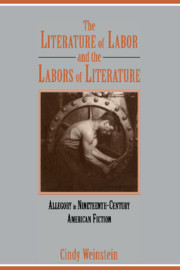 The Literature of Labor and the Labors of Literature
The Literature of Labor and the Labors of Literature Book contents
- Frontmatter
- Contents
- Acknowledgments
- Introduction
- 1 The Problem with Labor and the Promise of Leisure
- 2 Hawthorne and the Economics of Allegory
- 3 Melville's Operatives
- 4 Twain in the Man-factory
- 5 The Manikin, the Machine, and the Virgin Mary
- Afterword
- Notes
- Index
- CAMBRIDGE STUDIES IN AMERICAN LITERATURE AND CULTURE
2 - Hawthorne and the Economics of Allegory
Published online by Cambridge University Press: 06 July 2010
- Frontmatter
- Contents
- Acknowledgments
- Introduction
- 1 The Problem with Labor and the Promise of Leisure
- 2 Hawthorne and the Economics of Allegory
- 3 Melville's Operatives
- 4 Twain in the Man-factory
- 5 The Manikin, the Machine, and the Virgin Mary
- Afterword
- Notes
- Index
- CAMBRIDGE STUDIES IN AMERICAN LITERATURE AND CULTURE
Summary
The question of Hawthorne's relation to allegory has excited and plagued critics of Hawthorne ever since his short stories first appeared in the early 1830s. It even bothered Hawthorne, who in 1854 wrote to his publisher James T. Fields, “Upon my honor, I am not quite sure that I entirely comprehend my own meaning in some of these blasted allegories.” Following Hawthorne's own lead, contemporary readers continue to wrestle with the problem of Hawthorne and allegory and have come up with a variety of compelling explanations, many of which assume as their point of departure that Hawthorne was indeed experimenting with traditional allegory to create a new kind of allegory. The agreement ends there, as one cultural critic maintains that Hawthorne “modified] a sacrosanct Puritan form by mixing it with contemporary themes and styles” in order to “suit modern needs,” and another critic, one with a more formalist perspective, argues that Hawthorne “apparently adopts the allegorical mode in order to turn it against allegorical intentions. ” Although both of these views contribute to a greater understanding of Hawthorne's recasting of traditional allegory, this reading will suggest yet another explanation, in which allegorical characters reveal themselves as dialogically engaged with one of the nineteenth century's most powerful technologies of producing personhood - the developing market economy in antebellum America. If, on the one hand, allegory functions as a reminder of traditional texts (Bunyan would, of course, be the most obvious candidate in the case of Hawthorne) and a repository of traditional values, it becomes, on the other hand, a departure point for radically untraditional configurations of personhood that bear little relation to the religious world of Bunyan.
- Type
- Chapter
- Information
- The Literature of Labor and the Labors of LiteratureAllegory in Nineteenth-Century American Fiction, pp. 53 - 86Publisher: Cambridge University PressPrint publication year: 1995
- 1
- Cited by
